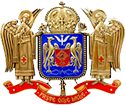The Revolution with national and social character from 1821, which led to the creation of the Romanian modern state, opened a new epoch for the Romanian Orthodox Church. In January 1859, a first stage of the Romanian political unification took place, through the unification of Moldova and Wallachia, under a single ruler, Alexandru Ioan Cuza (1859-1866). On January 11, 1865, metropolitan Nifon of Ungro-Wallachia received the title of “metropolitan primate”.
At the time of Alexandru Ioan Cuza, a series of measures were taken which led to deep changes in the religious life, required by the changes occurred in the state life (for example, the secularisation of the monasteries’ properties in 1863).
After the proclamation of the state independence of Romania (May 9, 1877), new negotiations with the Patriarchate followed, in view of recognising the autocephaly that was only a formal act, as the Romanian Church had enjoyed a special situation in comparison with other Orthodox Churches, that of a relative autocephaly towards the Ecumenical Patriarchate. It was only just on April 25, 1885, that the ecumenical patriarch Ioachim IV gave the usual “tomos” to acknowledge the autocephaly of the Orthodox Church in Romania.
The Romanian Church in Bukovina (Diocese of Cernauti) was raised to the rank of metropolitanate in 1873, while the Habsburg authorities hindered its relations with all the other Romanian dioceses. The most remarkable metropolitan was Silvestru Moraru Andrevici (1880-1895). The Church in Moldova beyond the Prut River (Bessarabia, passed under the Russian rule in 1812) constituted itself into an Archdiocese, seated in Kishinev, its first ruler being the Romanian Gavriil Banulescu Bodoni (1812 - 1821) (he was metropolitan of Poltava for a time), in whose time a Theological Seminary was set up in Kishinev and a new Romanian edition of the Bible was printed in Petersburg.
The Orthodox Church in Transylvania was ruled, in this period, by the great hierarch Andrei Saguna, an Aromanian (vicar in 1846, bishop in 1848, who was metropolitan between 1864 - 1873). He succeeded in re-establishing the old Metropolitanate of Transylvania, in 1864, seated in Sibiu this time, with two related dioceses: in Arad and in Caransebes (the last one set up in 1865). Saguna organised differently the Metropolitanate, through the well-known Organic Statute in 1868, and then headed the Church in Transylvania until after 1918, his principles constituting the basis of the religious rules in the entire Orthodox Church in the reunited Romania.
Theological education developed through the Seminaries in Socola-Iasi (1803), Bucharest, Buzau, Arges (1836), Ramnic (1837), Husi (1852), Roman (1858), Ismail-Galati (1864), through the Faculties of Theology in Iasi, for a short period (1860-1864); then through those in Cernauti (1875, instead of the old Theological Institute set up in 1827) and in Bucharest (1881). In Transylvania, Theological Seminaries and Institutes were set up in Blaj (1754), Sibiu (1811), Arad (1822) and Caransebes (1865).

